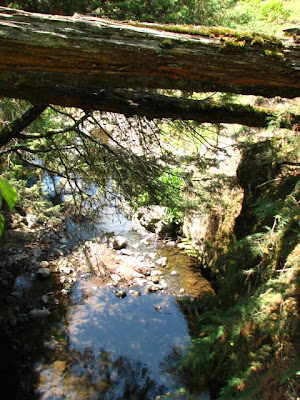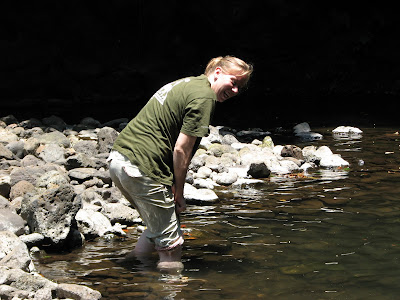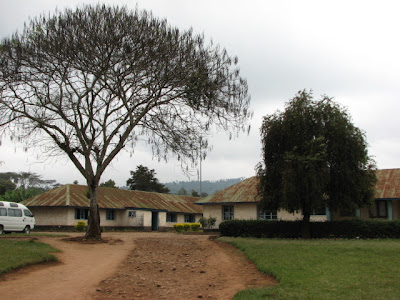A few days ago, Anna and I took off for two nights out of town. We went to the small town of Marangu on the lower slopes of Mt. Kilimanjaro, about a 3-hour drive from Arusha. There's a regional border between Arusha and Moshi where the police often pull drivers over for a routine check of insurance and license, and the officer in his white uniform was standing right in the middle of the road waving us over as we approached. (I think this was the same Maasai policeman that proposed marriage to me (joking only) when K2 and I passed this point on a jaunt back in April. You can read about that by clicking here. ) As I slowed, Anna said, "We'll charm them by speaking Swahili to them." I said, "No, everybody says pretend you don't know any Swahili and they'll let you go faster." Anna said, "No, when they're men, white girls speaking Swahili works better." So we pulled over, and as the policeman approached, I exchanged all the Swahili greetings I could think of, then said, "That's all my Swahili." He asked Anna if she spoke, too, and they had a friendly conversation through the window with several jokes. He took a perfunctory stroll around the front of the car, but barely even looked at the stickers, and did not ask for any money (which they sometimes do). He told Anna that I have a good head on my shoulders. Anna was right! He was very easily charmed, and then we went along our way.
We arrived in Marangu mid-afternoon. Although it was certainly African, it also had an alpine feel to it. It's odd to look at a stand of banana trees and think alpine, but that was the vibe. The little town was built on slopes and the buildings were not quite the same as down in Arusha. The air was cooler and there was much less dust and smoke to breathe. As we were walking, a Tanzanian man drove by, then pulled over and jumped out of his car smiling because he and Anna had worked together a few years ago at a lodge in the Kilimanjaro area. He also knew K2, whom he accurately described as "very talkative." It seems like a small world in Tanzania when even the foreigners run into people they know!
We spent two nights at a charming budget hotel, Babylon Lodge. (Here's their website.) The rooms were very simple, but clean and comfortable. The gardens and dining room were really pretty, not "budget" at all. It appeared that most of their customers are trekkers coming down from Mt. Kilimanjaro. Our first evening, we met two Belgian men who were still pumped up with adrenaline from reaching the summit. Anna and I were sitting on a couch outside our room, and the brunette walked right up, greeted each of us with a kiss on each cheek, and plopped down between us. Both of them saw me reading my Kindle and said, "iPad?" They were polite enough to act impressed when I explained what a Kindle is, even if it wasn't quite as exciting as an iPad. When I asked if they had summitted, the blonde said, "Of course!" And bragged that they had set a new speed record from the last camp to the summit. They were nice, but they made me a little tired.
The lodge staff were really fun and friendly, especially because we were speaking some Swahili. Anna's Swahili is quite good, so they were talking down to her while I could only understand parts of it.
Anna in the bustani (garden).
Datura flower growing outside our room. The evening before (when it was too dark to get a picture), this bush hosted a large preying mantis eating something (there wasn't enough of it left to see if it was her mate) and a few dozen bees all buzzing one particular flower.
Here's Anna demanding to know this young man's age. He had just greeted us both with shikamoo, a respectful greeting for someone a generation older than you or of high status. It turned out he's a year younger than she is, and she's not all that important, so he lost the argument. But to his credit, he did call her dada, or sister (meaning she's young), and call me mama, or mother (meaning I'm old).
The Missing Tanzanian Boyfriends Dinner Club on tour. OK, this was breakfast, but we didn't bring our cameras to dinner and the stairs back up to our room were too long. Usually I edit out pictures in which I look this bad, but I'm posting this one to show Anna (and a few other friends) that I do not always have the exact same perfect smile in every photo! And yes, our Tanzanian boyfriends were missing.
That's our room at the top of the stairs. I took this shot about halfway up.
I was sitting outside our room admiring my car parked at the bottom of the steps and feeling thrilled to own a car and to be out on a road trip.
We hired a guide to take us on a day hike through the hills. Attractions included a village with school, twin waterfalls, and secret Chagga (the tribe living in this area) tunnels. We opted out of the school tour because we are both working in schools and it was set up mostly so the school administrators can ask tourists for donations.
This beautiful girl in her Tanzania flag-inspired school uniform was the first of the day to ask us to take her picture.
We didn't go inside for the school tour, but the kids were outside on break. Anna told me a recent Australian visitor to the school where she works asked her if the school selected students based on "cuteness." No, of course not, but it looks like it because 100% of Tanzanian children are cute!
Children here really enjoy seeing their picture on that little digital viewscreen.
100% cute! Anna took this photo when they mobbed me to see the picture I had just taken of them.
Looking back at the African-Alpine town of Marangu.
We walked through the village of Ashira, a Chagga word meaning "place of war." That name became clear a bit later during our hike. But first, a few scenes around the village.
Students walking behind the school, with the old Lutheran church in the background.
Classrooms and cornfield.
Carrying bananas to market.
Old Lutheran church. The guide didn't offer much information, but my guess is it's German and predates World War I (because it looks old and the British took over after World War I).
Look! No backs on the pews. And church services here last for four hours! These mountain Chagga must be strong.
Our next stop was a Chagga tunnel. Historically, the Maasai tribe raided the Chagga to steal cattle. The Chagga used a system of tunnels in which the women, children, and cattle all hid together for days at a time until the battle was finished, or the Maasai couldn't find anybody and went home. The tunnels were used quite recently, up until the 1940's. I've met a lot of people from both of those tribes, and it's hard for me to imagine this kind of warfare. Although the Maasai do say they love cattle and the Chagga do say they love money!
Yes, of course we had to go inside. It was claustrophobic, hot, a little scary. Even I (5'3") had to bend over for most of the tunnel. (Photo taken by Anna.)
A great specimen of slime mold on the tunnel wall right inside the entrance.
The kitchen. The system includes ventilation tunnels running straight up to fresh air. When we saw this, Anna said, "It's as big as my kitchen."
And don't forget to feed all those cattle that are sharing this cramped, steamy space with you.
"Shira Tunnel--The Most Attractive Cultural Place." Well, you saw the slime mold, judge for yourself. Although Tanzanians use the English word "attractive" differently than Americans do. The meaning is broader and they use it more often. Here, it probably means "interesting." Also, notice only 15 to 20 people will be allowed inside. We only had five: me, Anna, our guide, and two local guides. It was so crowded, I thought I might die.
We came out with mud smeared on our hands, arms, knees, and faces. But one of the caretakers brought us a basin and pitcher of water for washing up. Attractive and gracious!
Aaah! Back in the open air. Thank you, Lord.
These impatiens grow wild in this area.
Our next stop, and no less attractive, was a double waterfall. We walked a couple of miles past the village and followed a trail along a stream.
I took this picture standing on a metal bridge with railings. The two mossy logs at the top of the picture are the old bridge, which would have scared me as much as the tunnel.
Our guide, John (a Chagga), and Anna at the waterfalls.
Here, Anna discovers that the water is freezing. And ten minutes later, she changed into her swimsuit and went in for a refreshing dip. I sat on the rocks high and dry on the bank...
...nestled among the impatiens...
...communing with the birds. I think this is a Mountain Wagtail. He matches the description in the guidebook I finally wrested away from K2, but there's no picture. He repeatedly flicked his tail up and down.
We walked back to the Babylon Lodge for a nice lunch and a 90-minute rest.The afternoon's itinerary included visits to a blacksmith and a reconstructed traditional Chagga house, plus a chance to sample mbege, the local banana beer. I had been feeling the effects of pneumonia during the morning walk, i.e., it's hard to gasp for air on the uphill when your lungs aren't doing their thing completely. So I opted out of the afternoon hike and relaxed at the Lodge. Anna finished the tour without me. She did graciously say it wasn't as fun without me.
Goats! A highlight of the afternoon. We don't know what the yellow markings are on the goat on the right. (Photo taken by Anna.)
Anna passed on the mbege. She already knows she doesn't like it.
The next day on our way home, we made a side trip to Machame, a small town also low on the flanks of Kilimanjaro. We visited Machame Girls Secondary School, which was established by Anna's great aunt, Nancy King, in 1947. She was the first head mistress and lived in Tanzania for several years. She also was the first foreign woman to summit Mt. Kilimanjaro. So Anna comes by her adventurous spirit naturally!
Anna with the current headmistress. N. King is the first in the list of "heads" on the signboard, with a tenure of 1946 to 1957.
The headmistress was just on her way out to the hairdresser, but she graciously took the time to give us a tour of the school. Some of the facilities are good, but much of the school is in need of repairs and updating. She's determined to improve the school; her tour reminded me of the head matron of the orphanage in the Number One Ladies' Detective Agency books who always gets Mr. J.L.B. Matekoni to donate some repair work.
Most of the girls had gone home for a school break (it's a boarding school), but this class was still here working.
Here's the kitchen for feeding 500 girls.
One of Miss King's goals for the school was that the girls learn practical skills. This is the agriculture lab, where a few girls were studying for an exam. The school grows corn and raises a few cows to feed the students, and the girls do some of the work. The headmistress told us the cooking program is still going strong, but not many girls sign up for tailoring, since they prefer modern clothes to traditional African dresses.
Mountain mist over the livestock sheds.
The three days away were the perfect break. I'm hoping for more road trips soon!
A final note: I went back to the big Lutheran hospital yesterday. After a chest x-ray, the doctor said I don't have pneumonia, maybe just bronchitis. So I'm improving, and all my friends back home, don't worry...






















































Glad you are back into the swing of things, and that your health is improving. It sounds like your road trip was a lot of fun. The photos were great (as always).
ReplyDeleteFabulous photo journal. And Yes to no pneumonia. Carol Brown
ReplyDeleteThanks you for the information and photos.I would like to make one correction for the meaning of 'Ashira'. Ashira means the place that stinks. The natives (Chagga) used to dump their dead around this area, so the place was always stinking
ReplyDeletewe are glad you enjoyed your visit to Marangu. The photos are amazing. We wish you all the best!
ReplyDeleteThe Ashira Church was one of the early Lutheran Churches built in Marangu and was built by the German missionaries certainly with African labor. There is another old church in (Old) Moshi.
ReplyDeleteWelldone job!!
ReplyDeleteI would like to see more pictures of the very first building/structure done by woods and mud with grass roofing. Also the first Missionary and Makundi Family saved at the parish/centre.
Thanks - Rish Moses Urio